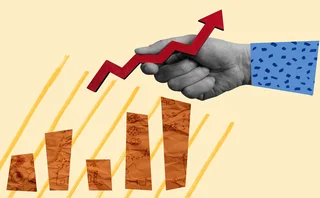
Credit Suisse uses neural nets to call minute-ahead forex
Bank encases AI in ‘control framework’ to curb risk and will stick to micro timeframe for now

Credit Suisse’s foreign exchange group is using deep learning for minute-to-minute price forecasting, harnessed by a control framework to keep the bank from taking on too much risk.
“This used to be a business where you’d just have a bunch of people in the room buying and selling currencies, and now it’s gotten to the point where AI is part of the solution,” says John Estrada, global co-head of forex spot trading at Credit Suisse.
Deep learning, also called deep neural networks, is a subset of machine learning in artificial intelligence (AI) that tries to mimic the functioning of the human brain. Its networks are capable of both ‘supervised’ learning – in which they are fed data with known relationships – and ‘unsupervised’ – where algorithms find relationships on their own from inside a tangle of data.
Credit Suisse took a supervised approach using data from its order books in the interbank markets. Those inputs – bids, asks, sizes of both, time elapsed since the last price change, and other indicators like momentum signals and order-book imbalance – are then put into a neural net that teaches itself to predict single-digit price movements based on historical data.
“Over a few hours, a lot of computer time, what happens is the neural net actually learns how to use the input market data to predict price movements. Once you have that, you take it out of the learning framework, and you put it into production,” says Estrada. “As long as you have a good control framework around it, it just drops in and works.”
Credit Suisse declined to put a figure on how much the model has improved its forecasts. But since September, when it replaced its traditional linear-regression forecasting model with the AI, the forex team has seen a “dramatic” decrease in spreads, achieved primarily by a reduction in the market wakes produced by larger trades – a plus for clients, Estrada says.
“When you get large trades, with the old model you would have lots of market impact and have to charge clients more. Our new model tightens up the big sizes,” he says. “Then on the hedge side or the internalisation side, we are using the AI engine to get out of the risk slowly and at good levels, and so it has really impacted our ability to price very large trades very aggressively.”
Market-makers typically skew prices so as to elicit trades that reduce their own risk, enabling them to exit positions with offsetting client trades – a practice known as internalisation – instead of through costlier interbank hedges.
Others in the industry beside Credit Suisse have sought to use machine learning models in trading, though typically to schedule trades and so reduce market impact more than to forecast price moves.
On the hedge side or the internalisation side, we are using the AI engine to get out of the risk slowly and at good levels, and so it has really impacted our ability to price very large trades very aggressively
John Estrada, Credit Suisse
Yet another aspect of deep learning models is that they are ‘uninterpretable’, that is, no-one knows how they come up with their predictions. Because of that ‘black box’, many in the financial industry no more than dabble in them, while others steer clear altogether.
To allay the scepticism, Credit Suisse has housed its AI engine in a control framework to make sure the bank doesn’t “take on too much risk”.
“With the neural net pricer, there is more or less no explainability, and for a lot of our competitors that caused a big problem,” Estrada says. “This can be addressed by implementing the right control framework to make sure that whatever the neural net comes up with, the pricing will be appropriate.”
The control framework ensures the price changes provided by the neural nets are not too large or unfairly move the market or clients’ prices. The nets also shut down if the machine goes too far afield; for example, the machine will stop producing prices if a client’s limits are breached.
According to Estrada, the controls come into play “all the time”.
“If the neural net gets too excited and thinks the markets are going to go up a ton, we still can’t skew our price that much,” he says. “When markets get very wide, and we’re more uncertain about the price or the mid [middle price], then the use of the neural net will drop out automatically.”
A number of factors came together in the last few years that led Credit Suisse to look more closely at deep learning. One was a change in mindset at the bank – in the market, it is still a debate whether AI can call prices – as well as the availability of cheap cloud-computing power for data analysis.
“The other part which is probably up there in importance is getting all the pieces together: a franchise that’s big enough to support these types of improvements, a system which is stable enough, getting regulators comfortable that your control framework has been engineered to the point that it can provide a container around an AI tool,” Estrada adds.
For the time being, the bank is only forecasting single-digit, right-now prices and that is all. The longer the horizon, the more randomness in the way prices move.
And by longer term, they can mean as little as a week. Trying to predict what is going to happen to dollar/yen over the next seven days, for example, introduces actors like central bankers and politicians, Estrada notes, and as yet, there is no way to factor in those data points.
“We’re forecasting in the single-digit minutes, and that was pretty hard,” says Estrada, adding that it took a few years to nail down. “If you ask me how long it will take until we’re in the single-digit months, I would say it’s going to be probably quite a while.”
Only users who have a paid subscription or are part of a corporate subscription are able to print or copy content.
To access these options, along with all other subscription benefits, please contact info@risk.net or view our subscription options here: http://subscriptions.risk.net/subscribe
You are currently unable to print this content. Please contact info@risk.net to find out more.
You are currently unable to copy this content. Please contact info@risk.net to find out more.
Copyright Infopro Digital Limited. All rights reserved.
As outlined in our terms and conditions, https://www.infopro-digital.com/terms-and-conditions/subscriptions/ (point 2.4), printing is limited to a single copy.
If you would like to purchase additional rights please email info@risk.net
Copyright Infopro Digital Limited. All rights reserved.
You may share this content using our article tools. As outlined in our terms and conditions, https://www.infopro-digital.com/terms-and-conditions/subscriptions/ (clause 2.4), an Authorised User may only make one copy of the materials for their own personal use. You must also comply with the restrictions in clause 2.5.
If you would like to purchase additional rights please email info@risk.net
More on Investing
How investment firms are innovating with quantum technology
Banks and asset managers should be proactive in adopting quantum-safe strategies
Top 10 investment risks for 2026
AI, strained governments, inflated private assets: risky bets have become hard to avoid
Review of 2025: It’s the end of the world, and it feels fine
Markets proved resilient as Trump redefined US policies – but questions are piling up about 2026 and beyond
Asset managers prep autocall ETFs with assets tipped to hit $30bn
Actively managed strategies wait in the wings after systematic approach nets Calamos $500m
Citi launches core inflation QIS
Custom indexes eliminate energy and food prices to ease trading of stickier inflation trends
BlackRock appoints Pierre Sarrau as chief risk officer
Current CRO Edward Fishwick will be head of research at BlackRock’s RQA group
Japan’s yen swaps go global
JSCC isn’t just clearing swaps, it is clearing the way for the next stage of Japan’s financial evolution
How Bessent learned to stop worrying and love the T-bill
Short-dated issuance shows no signs of slowing. Some fear it could end badly.







